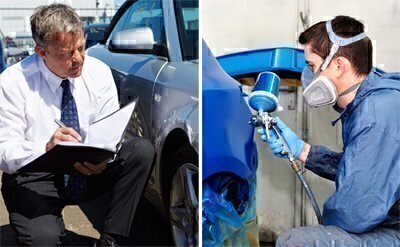Dealing with Your Insurer When Your Car Needs Body Repairs
Last updated May 2022
If your insurance or another party’s insurance will pay for your repair (as is the case with more than 80 percent of all bodywork), make sure the insurance company doesn’t cut corners. Your shop can be an expert ally in this effort, but you yourself must make the right moves.
 Always report an accident as soon as possible. If your car suffers only minor damage, and you are certain there are no structural or other safety-related problems, follow the instructions of the responsible insurance company. You probably will be asked to use a drive-in claims center that will provide an authorized repair-cost figure and the names of body shops willing to make the repairs for that amount. Using a drive-in service is convenient, but use one only when there is cosmetic damage.
Always report an accident as soon as possible. If your car suffers only minor damage, and you are certain there are no structural or other safety-related problems, follow the instructions of the responsible insurance company. You probably will be asked to use a drive-in claims center that will provide an authorized repair-cost figure and the names of body shops willing to make the repairs for that amount. Using a drive-in service is convenient, but use one only when there is cosmetic damage.
Some insurers offer another option: Take your car to a company-designated shop and have the repairs made without obtaining approval. If you need only minor repairs, this is an acceptable option.
But if there is even a possibility of more serious damage, take your car directly to your body shop of choice and tell the insurer to send its estimator there. For serious repairs, you need the shop to advocate for quality. Don’t count on your insurance company to look out for your interests. Also, bringing your car to a body shop rather than an insurance company’s drive-in appraisal center allows the company’s adjuster to make a thorough inspection for hidden damage.
If your car must be towed, a drive-in appraisal center is not really an option. Have it towed to the shop of your choice, and ask the shop to pay the towing charges, so they are included in your final bill.
Regardless of where the appraisal is done, the insurer may offer less than your shop’s estimate and suggest shops that will make the repairs for its price. You then have three choices: Take your car to one of the insurer’s shops; leave the car at your shop and pay the difference out of your own pocket; or leave the car at your shop and dispute the insurance company’s offer.
If there is a dispute, it is very important to understand where your shop and the insurer differ. Ask the shop to explain exactly why its estimate is higher; the difference might represent work that doesn’t matter to you. For example, the shop may insist that certain required parts must be new, not used as directed by the insurer. If safety is not at issue, the fight may not be worth the effort.
If you can’t live with the insurer’s estimate, and your claim is on your own policy, check the policy for an arbitration provision. Arbitration can be time-consuming (meaning you’ll probably have to pay repair costs yourself while arbitration proceeds), but it gives you a good chance to get a fair shake.


